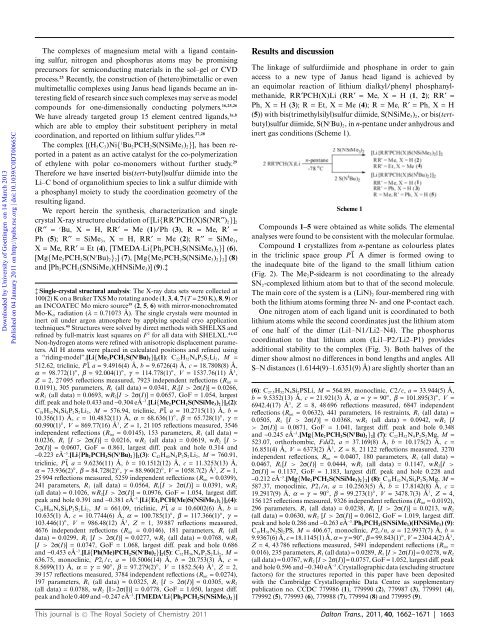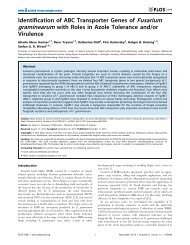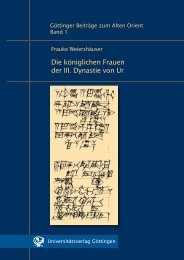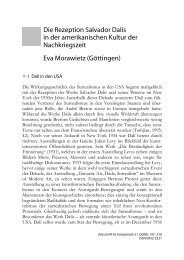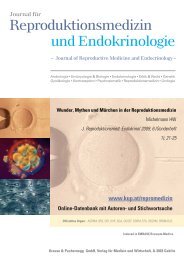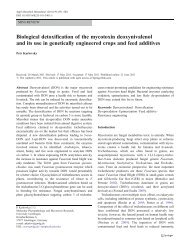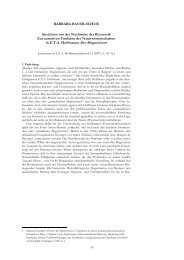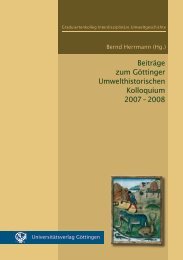Dalton Transactions
Dalton Transactions
Dalton Transactions
Create successful ePaper yourself
Turn your PDF publications into a flip-book with our unique Google optimized e-Paper software.
Downloaded by University of Goettingen on 14 March 2013<br />
Published on 04 January 2011 on http://pubs.rsc.org | doi:10.1039/C0DT00665C<br />
The complexes of magnesium metal with a ligand containing<br />
sulfur, nitrogen and phosphorus atoms may be promising<br />
precursors for semiconducting materials in the sol–gel or CVD<br />
process. 25 Recently, the construction of (hetero)bimetallic or even<br />
multimetallic complexes using Janus head ligands became an interesting<br />
field of research since such complexes may serve as model<br />
compounds for one-dimensionally conducting polymers. 16,25,26<br />
We have already targeted group 15 element centred ligands, 1a,b<br />
which are able to employ their substituent periphery in metal<br />
coordination, and reported on lithium sulfur ylides. 27,28<br />
The complex [(H 5C 3)Ni{ t Bu 2PCH 2S(NSiMe 3) 2}], has been reported<br />
in a patent as an active catalyst for the co-polymerization<br />
of ethylene with polar co-monomers without further study. 29<br />
Therefore we have inserted bis(tert-butyl)sulfur diimide into the<br />
Li–C bond of organolithium species to link a sulfur diimide with<br />
a phosphanyl moiety to study the coordination geometry of the<br />
resulting ligand.<br />
We report herein the synthesis, characterization and single<br />
crystal X-ray structure elucidation of [Li{RR¢PCH(X)S(NR¢¢) 2}] 2<br />
(R¢¢ = t Bu, X = H, RR¢ = Me (1)/Ph (3), R = Me, R¢ =<br />
Ph (5); R¢¢ = SiMe 3, X = H, RR¢ = Me (2); R¢¢ = SiMe 3,<br />
X = Me, RR¢ =Et (4), [TMEDA·Li{Ph 2PCH 2S(NSiMe 3) 2}] (6),<br />
[Mg{Me 2PCH 2S(N t Bu) 2} 2](7), [Mg{Me 2PCH 2S(NSiMe 3) 2} 2](8)<br />
and [Ph 2PCH 2(SNSiMe 3)(HNSiMe 3)] (9).‡<br />
‡ Single-crystal structural analysis: The X-ray data sets were collected at<br />
100(2) K on a Bruker TXS Mo rotating anode (1, 3, 4, 7 (T = 250 K), 8, 9)or<br />
an INCOATEC Mo micro source 39 (2, 5, 6) with mirror-monochromated<br />
Mo-K a radiation (l = 0.71073 A˚ ). The single crystals were mounted in<br />
inert oil under argon atmosphere by applying special cryo application<br />
techniques. 40 Structures were solved by direct methods with SHELXS and<br />
refined by full-matrix least squares on F 2 for all data with SHELXL. 41,42<br />
Non-hydrogen atoms were refined with anisotropic displacement parameters.<br />
All H atoms were placed in calculated positions and refined using<br />
a “riding-model”.[Li{Me 2PCH 2S(N t Bu) 2}] 2(1): C 22H 52N 4P 2S 2Li 2, M =<br />
512.62, triclinic, P1¯, a = 9.4916(4) A˚ , b = 9.6726(4) A˚ , c = 18.7808(8) A˚ ,<br />
a = 98.772(1) ◦ , b = 92.004(1) ◦ , g = 114.778(1) ◦ , V = 1537.76(11) A˚ 3 ,<br />
Z = 2, 27 095 reflections measured, 7923 independent reflections (R int =<br />
0.0191), 305 parameters, R 1 (all data) = 0.0341, R 1[I > 2s(I)] = 0.0266,<br />
wR 2 (all data) = 0.0693, wR 2[I > 2s(I)] = 0.0657, GoF = 1.054, largest<br />
diff. peak and hole 0.433 and -0.304 eA˚ -3 .[Li{Me 2PCH 2S(NSiMe 3) 2}] 2(2):<br />
C 18H 52N 4Si 4P 2S 2Li 2, M = 576.94, triclinic, P1¯, a = 10.2715(11) A˚ , b =<br />
10.356(11) A˚ , c = 10.4832(11) A˚ , a = 68.636(1) ◦ , b = 65.728(1) ◦ , g =<br />
60.990(1) ◦ , V = 869.77(16) A˚ 3 , Z = 1, 21 105 reflections measured, 3546<br />
independent reflections (R int = 0.0145), 153 parameters, R 1 (all data) =<br />
0.0236, R 1 [I > 2s(I)] = 0.0216, wR 2 (all data) = 0.0619, wR 2 [I ><br />
2s(I)] = 0.0607, GoF = 0.861, largest diff. peak and hole 0.314 and<br />
-0.223 eA˚ -3 .[Li{Ph 2PCH 2S(N t Bu) 2}] 2(3): C 42H 60N 4P 2S 2Li 2, M = 760.91,<br />
triclinic, P1¯, a = 9.6236(11) A˚ , b = 10.1512(12) A˚ , c = 11.3253(13) A˚ ,<br />
a = 73.936(2) ◦ , b = 84.728(2) ◦ , g = 88.960(2) ◦ , V = 1058.7(2) A˚ 3 , Z = 1,<br />
25 994 reflections measured, 5259 independent reflections (R int = 0.0399),<br />
241 parameters, R 1 (all data) = 0.0564, R 1[I > 2s(I)] = 0.0391, wR 2<br />
(all data) = 0.1026, wR 2[I > 2s(I)] = 0.0976, GoF = 1.054, largest diff.<br />
peak and hole 0.391 and -0.381 eA˚ -3 .[Li{Et 2PCH(Me)S(NSiMe 3) 2}] 2(4):<br />
C 24H 64N 4Si 4P 2S 2Li 2, M = 661.09, triclinic, P1¯, a = 10.6002(6) A˚ , b =<br />
10.635(1) A˚ , c = 10.7744(6) A˚ , a = 100.785(1) ◦ , b = 117.366(1) ◦ , g =<br />
103.446(1) ◦ , V = 986.48(12) A˚ 3 , Z = 1, 39 887 reflections measured,<br />
4676 independent reflections (R int = 0.0146), 181 parameters, R 1 (all<br />
data) = 0.0299, R 1 [I > 2s(I)] = 0.0277, wR 2 (all data) = 0.0768, wR 2<br />
[I > 2s(I)] = 0.0747, GoF = 1.068, largest diff. peak and hole 0.686<br />
and -0.453 eA˚ -3 .[Li{Ph(Me)PCH 2S(N t Bu) 2}] 2(5): C 32H 56N 4P 2S 2Li 2, M =<br />
636.75, monoclinic, P2 1/c, a = 10.5006(14) A˚ , b = 20.753(3) A˚ , c =<br />
8.5699(11) A˚ , a = g = 90 ◦ , b = 97.279(2) ◦ , V = 1852.5(4) A˚ 3 , Z = 2,<br />
39 157 reflections measured, 3784 independent reflections (R int = 0.0274),<br />
197 parameters, R 1 (all data) = 0.0325, R 1 [I > 2s(I)] = 0.0305, wR 2<br />
(all data) = 0.0788, wR 2 [I>2s(I)] = 0.0778, GoF = 1.050, largest diff.<br />
peak and hole 0.409 and -0.247 eA˚ -3 .[TMEDA ∑ Li{Ph 2PCH 2S(NSiMe 3) 2}]<br />
Results and discussion<br />
The linkage of sulfurdiimide and phosphane in order to gain<br />
access to a new type of Janus head ligand is achieved by<br />
an equimolar reaction of lithium dialkyl/phenyl phosphanylmethanide,<br />
RR¢PCH(X)Li (RR¢ = Me, X = H(1, 2); RR¢ =<br />
Ph, X = H(3); R = Et, X = Me (4); R = Me, R¢ =Ph, X = H<br />
(5)) with bis(trimethylsilyl)sulfur diimide, S(NSiMe 3) 2, or bis(tertbutyl)sulfur<br />
diimide, S(N t Bu) 2,inn-pentane under anhydrous and<br />
inert gas conditions (Scheme 1).<br />
Scheme 1<br />
Compounds 1–5 were obtained as white solids. The elemental<br />
analyses were found to be consistent with the molecular formulae.<br />
Compound 1 crystallizes from n-pentane as colourless plates<br />
in the triclinic space group P1¯. A dimer is formed owing to<br />
the inadequate bite of the ligand to the small lithium cation<br />
(Fig. 2). The Me 2P-sidearm is not coordinating to the already<br />
SN 2-complexed lithium atom but to that of the second molecule.<br />
The main core of the system is a (LiN) 2 four-membered ring with<br />
both the lithium atoms forming three N- and one P-contact each.<br />
One nitrogen atom of each ligand unit is coordinated to both<br />
lithium atoms while the second coordinates just the lithium atom<br />
of one half of the dimer (Li1–N1/Li2–N4). The phosphorus<br />
coordination to that lithium atom (Li1–P2/Li2–P1) provides<br />
additional stability to the complex (Fig. 3). Both halves of the<br />
dimer show almost no differences in bond lengths and angles. All<br />
S–N distances (1.6144(9)–1.6351(9) A˚ ) are slightly shorter than an<br />
(6): C 27.5H 52N 4Si 2PSLi, M = 564.89, monoclinic, C2/c, a = 33.944(5) A˚ ,<br />
b = 9.5352(13) A˚ , c = 21.921(3) A˚ , a = g = 90 ◦ , b = 101.895(3) ◦ , V =<br />
6942.4(17) A˚ 3 , Z = 8, 48 696 reflections measured, 6847 independent<br />
reflections (R int = 0.0632), 441 parameters, 16 restraints, R 1 (all data) =<br />
0.0505, R 1 [I > 2s(I)] = 0.0368, wR 2 (all data) = 0.0942, wR 2 [I<br />
> 2s(I)] = 0.0871, GoF = 1.041, largest diff. peak and hole 0.348<br />
and -0.245 eA˚ -3 .[Mg{Me 2PCH 2S(N t Bu) 2} 2](7):C 22H 52N 4P 2S 2Mg, M =<br />
523.07, orthorhombic, Fdd2, a = 37.169(8) A˚ , b = 10.175(2) A˚ , c =<br />
16.851(4) A˚ , V = 6373(2) A˚ 3 , Z = 8, 21 122 reflections measured, 3270<br />
independent reflections, R int = 0.0407, 180 parameters, R 1 (all data) =<br />
0.0467, R 1[I > 2s(I)] = 0.0444, wR 2 (all data) = 0.1147, wR 2[I ><br />
2s(I)] = 0.1137, GoF = 1.183, largest diff. peak and hole 0.228 and<br />
-0.212 eA˚ -3 .[Mg{Me 2PCH 2S(NSiMe 3) 2} 2](8):C 18H 52N 4Si 4P 2S 2Mg, M =<br />
587.37, monoclinic, P2 1/n, a = 10.2563(5) A˚ , b = 17.8142(8) A˚ , c =<br />
19.2917(9) A˚ , a = g = 90 ◦ , b = 99.273(1) ◦ , V = 3478.7(3) A˚ 3 , Z = 4,<br />
156 125 reflections measured, 9326 independent reflections (R int = 0.0192),<br />
296 parameters, R 1 (all data) = 0.0238, R 1 [I > 2s(I)] = 0.0213, wR 2<br />
(all data) = 0.0630, wR 2 [I > 2s(I)] = 0.0612, GoF = 1.019, largest diff.<br />
peak and hole 0.286 and -0.263 eA˚ -3 .Ph 2PCH 2(SNSiMe 3)(HNSiMe 3)(9):<br />
C 19H 31N 2Si 2PS, M = 406.67, monoclinic, P2 1/n, a = 12.9937(7) A˚ , b =<br />
9.9367(6) A˚ , c = 18.1145(1) A˚ , a = g = 90 ◦ , b = 99.843(1) ◦ , V = 2304.4(2) A˚ 3 ,<br />
Z = 4, 43 786 reflections measured, 5491 independent reflections (R int =<br />
0.016), 235 parameters, R 1 (all data) = 0.0289, R 1 [I > 2s(I)] = 0.0278, wR 2<br />
(all data) = 0.0767, wR 2 [I > 2s(I)] = 0.0757, GoF = 1.052, largest diff. peak<br />
and hole 0.596 and -0.340 eA˚ -3 .Crystallographic data (excluding structure<br />
factors) for the structures reported in this paper have been deposited<br />
with the Cambridge Crystallographic Data Centre as supplementary<br />
publication no. CCDC 779986 (1), 779990 (2), 779987 (3), 779991 (4),<br />
779992 (5), 779993 (6), 779988 (7), 779994 (8) and 779995 (9).<br />
This journal is © The Royal Society of Chemistry 2011 <strong>Dalton</strong> Trans., 2011, 40, 1662–1671 | 1663


